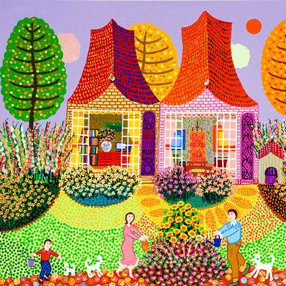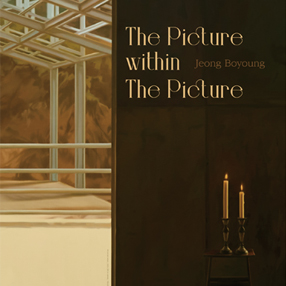본문
-
김선영
THE SALT VESSEL201121, Mixed media, 540x350x190mm, 2011, 개인소장
김선영
THE SALT VESSEL 201001, Mixed media, 400x370x170mm, 2010, 개인소장
김선영
THE SALT VESSEL201202, Mixed media, 140x190x80mm, 2012, 개인소장
Press Release
김선영의 조각 여성신화와 종교적인 아이콘
고충환(Kho, Chung-Hwan 미술평론)
김선영이 빚어낸 형상들에는 어머니가 깃들어 있다. 그녀는 가슴과 같은 신체의 일부이거나 혹은 눈물과 같은 신체 분비물이 고착된 형태로 나타난다. 더불어 저고리나 골무처럼 그녀의 채취가 배어 있는 사물들로 나타나기도 하고, 항아리인 양 통치마의 형태로 현상하기도 한다. 그녀는 작가 자신의 어머니인 동시에 어머니로서의 삶을 사는 자기 자신이다. 더 나아가 그녀는 자신과 어머니를 넘어선 존재, 근원적인 어머니, 우주모(宇宙母), 지모(地母)이기도 하다. 그러니까 어머니는 과거와 현재 그리고 미래마저도 하나로 잇는 시간의 축인 동시에 작가가 존재하는 이유 즉 인과론의 굴레인 것이다. 작가의 작업 속에서 그녀는 이질적이고 무관계한 동물들을 관계의 망 속에 거둬들이는 자연으로 나타나는가 하면(이는 net 곧 망이란 주제 아래 포함된다), 그 자연의 식솔들을 자기 속에 아우르는 둥지의 형태로 현상하기도 한다(이는 nest 즉 일종의 둥지 의식으로 암시된다). 이처럼 작가는 자연과 우주 그리고 원형으로 나타난 어머니의 존재로써 여성으로서의 성적 특수성을 드러내고, 자기 반성적 사유를 위한 구실로 삼는다. 이로써 작가의 개인사적인 경험을 넘어서 보편적인 개념과 가치마저 획득한다.
김선영의 근작을 관통하는 주제는 함께 만들어 가는 사회, 함께 살아가는 사회다. 이렇게 적어놓고 보니, 왠지 그 행간에서 예술교육론 혹은 예술효용론이 어른거리는 듯하다. 예술이 삶을 변화시킬 수 있다는 신념, 예술이 삶에 영향을 미치고 삶의 질을 향상시킬 수 있다는 의지가 엿보인다. 그러나 여기서의 문제는 이 끈질긴 계몽에의 유혹이 지금도 여전히 타당한가를 묻고자 하는 것이 아니라, 작가가 예술에다가 거의 종교와도 같은 의미를 부여하고 있다는 것이다. 예술로부터 삶을 정화시켜 줄만한 요소를 찾고, 삶을 거듭나게 할만한 계기를 찾는 것이다. 이는 작가의 작업으로 하여금 서사적이고, 내용적이고, 의미론적인 문법에 정박케 한다. 그렇다고 작가의 작업이 설명적이라는 말은 아니다. 오히려 암시적이고, 상징적이고, 함축적이다.
이는 작가의 작업에서 여러 비어 있는 다양한 형태의 의자들로 나타난다. 의자들은 저 홀로 놓여져 있기도 하고, 테이블을 사이에 둔 채 마주하고 있기도 하다. 이때의 빈 의자는 존재를 상징한다. 의자가 존재이며 몸인 것이다. 의자의 표면에는 여러 비정형의 스크래치와 요철이 확인되며, 이는 작가의 개인사로부터 복원해낸 삶의 상처, 삶의 시간, 삶의 지층, 삶의 흔적들을 암시한다. 그리고 의자들은 하나같이 연붉은빛을 머금은 살색으로 나타나는데, 이 역시 존재로서의 의자, 존재로서의 몸을 강화한다. 그리고 의자가 마주하고 있는 테이블 한가운데에는 마치 완만한 분화구처럼 움푹 패어진 부분이 있고, 그 속에는 물이 담겨져 있다. 그 물은 말할 것도 없이 삶의 바다를 암시하는 메타포의 일종으로서 도입된 것이며, 그 물 위에 떠 있는 작은 배는 그 삶의 바다에 던져진 존재를 상징한다. 작가의 작업에 나타난 존재가 의자로부터 배로 변주된 것이다. 이로써 작가의 작업은 마치 의자로 대리된 존재들이 벌이는 한편의 무언극, 사물극을 떠올리게 한다. 이때 무대 위에 올려진 사물들에게 부여된 상황은 말할 것도 없이 삶을 연기하는 것이다.
이처럼 존재로서의 의자, 삶을 대리하는 의자는 비록 비어 있지만, 그 부재함은 정작 존재 자체보다도 더 강하게 존재를 환기시킨다. 잠재적이고 가능한 주체, 익명적이고 보편적인 주체를 향해 열려 있음으로 인해 쉽게 공감을 불러일으킨다. 말하자면 존재 자체로서보다는 부재를 통해서 존재를 증명하는 셈이다. 이는 작가의 지인들을 상대로 해서 그들의 얼굴을 떠낸 마스크 형태의 부조 작업에서도 확인된다. 이 일련의 작업들에 나타난 음각 된 얼굴들은 마치 네거티브 필름이 존재의 무의식적 실체를 암시하는 것과 마찬가지로, 존재 자체보다는 존재의 흔적에 가깝다. 그로부터는 오직 존재가 빠져나간 흔적, 존재가 남긴 자국, 한때 존재의 실체를 간직하고 있었음을 떠올리게 하는 빈 공간, 여백을 확인할 수 있을 따름이다. 하지만 이때의 여백은 결코 공허하지가 않다. 이는 오히려 감각적 형태로는 붙잡을 수 없는 존재의 실체를 더 강하게 환기시켜준다.
더불어 지인들의 얼굴, 타자들의 얼굴, 익명의 얼굴들은 작가의 주체가 생산된 배경에 대해 말해준다. 그러니까 주체란 타자들과의 보이지 않는 관계를 전제로 한 것이며, 하나의 인격이란 익명적 주체와의 영향사로부터 생겨난 것이다. 주체와 타자 그리고 익명적 주체를 아우르는 이러한 존재의 인식은 함께 하는 삶, 더불어 사는 사회에 맞춰진 작가의 주제의식과도 통하는 것이다. 주체와 타자, 너와 나를 결속시켜주는 존재의 끈은 어머니로부터 나에게로 연이어진 존재의 끈만큼이나 결정적이고 끈질기다.
나는 너로부터 비롯되었으며, 모든 존재는 서로 연속돼 있다는 이러한 인식은 작가의 작업에서 기독교적인 세계관과 접맥되면서 일종의 종교적이고 보편적인 가치를 획득하게 된다. 즉 기독교적인 도상학, 기독교적인 세계관은 김선영의 작업 도처에서 암시적이고 상징적인 형태로 나타난다. 예컨대 등받이가 있는 의자와 세숫대야가 한 벌의 세트로 나타난 작업은 예수께서 제자들의 발을 씻긴 세족식(洗足式)을 모티브로 했을 것이다. 그리고 마치 물을 담듯 모아 쥔 두 손위에 얹혀진 책의 형상은 신의 말씀을 귀하게 받든다는 의미를 함축하고 있다.
그런가하면 소금을 가득 실은 긴 배의 형상은 빛과 함께 예수께서 제자들에게 명하신 지상과제를 형상화한 것이다(너희는 세상을 밝히는 빛과 소금이 되라). 여기서 배의 형상을 마구간의 구유로 읽게 되면, 이는 곧 낮은 곳으로 임하신 절대자의 탄생 배경을 말해준다. 이렇듯 작가의 작업에 나타난 기독교적 도상들은 그 자체에만 머물기보다는 그 의미가 확대 재생산되면서 일종의 보편성을 획득하게 된다. 즉 배는 그 자체 망망대해로 나타난 삶의 바다를 항해하는 주체를 의미하기도 하고, 이와 동시에 유선형으로 나타난 특유의 형상이 어머니의 가슴이나 어머니의 눈물을 암시하기도 한다. 그 가슴과 눈물은 배와 바다를 가리고도 남을 만큼의 위대한 사랑으로 나타난다. 그리고 그 가슴과 눈물의 주체인 어머니는 우주의 근원적 존재, 즉 우주모이며 지모에 다름 아니다. 작가의 전작에 나타난 어머니의 신화가 근작에서는 절대적 존재로 변주되고 있으며, 이는 작가의 작업 속에서 서로 구분되지가 않는다. 이를테면 긴 돌기가 달린 깔때기 형태 속에 가득 담긴 소금 형상은 어머니의 가슴과 눈물을, 그리고 소금으로 화한 절대자의 몸(顯顯)을 동시에 함축해내고 있는 것이다.
이처럼 김선영의 작업은 개인사를 넘어 보편적인 경험의 지평에로까지 확장되고, 기독교적인 도상학을 넘어 여성신화에 연결된다. 허나 이를 현재의 시점으로 되살려내려는 의식적인 행위로서보다는, 일상성이라는 프리즘을 통해서 자연스레 드러난 무의식의 산물이자 체질의 결과물로서 보인다. 개인사와 보편사, 여성신화와 종교적인 아이콘이 서로 중첩된 서사적이고 암시적인 형상들이 개인적이고 표면적인 차이를 넘어, 근원적인 존재와 자기 반성적 사유에 맞닿아 있다.
Sculpture of Sun-Young Kim
Female Myth and Religious Icon
(Kho, Chung-Hwan Arts Review)
There is mother dwelling in the images shaped by Sun-Young Kim. She builds forms of breasts as part of body or of tears as secretion from body. Besides objects like ‘geogori' Korean traditional female jacket or thimble are shown, and skirts looking like jar, too. She is the mother of artist herself, at the same time herself living as a mother. Furthermore she is some fundamental mother, universal mother, earth mother, the existence beyond herself and mother. That is, mother is an axis linking past, present and even future together, as well as the reason for which the artist exists, the bridle of casualty. In the works of the artist, she is shown as nature which gathers the heterogeneous and irrelevant animals into the net of relationship(included under the theme of net), or as nest in which the members of nature come(alluded as a sort of nest rite). Likewise with the existence of mother shown in nature, universe and prototype the artist features the outstanding characteristic of woman and takes tools as the artist's own reflection. Now acquired are universal concepts and values beyond personal experiences.
The recent works of Sun-Young Kim are about the society making together, the society living together. Saying like this seems about the education theory of arts or the effective value of arts in lines. It implies the faith that arts can change, affect, and improve life. However, the problem here is not the validity for the temptation of persistent enlightenment, but the same meaningfulness like religion which the artists put in arts; to find elements purifying life and chance giving rebirth of life from arts. It makes the works descriptive, contextive and semantic grammar. That does not mean the works are explanatory. Rather, they are alluding, symbolic and implicative.
It is shown in the works with the various types of empty chairs. The chairs are often put alone, or put opposite table. The empty chairs here symbolize existence. The chairs are existence and body. The surface of chairs consists of different forms of scratches alluding the scars of life, time of life, traces of life duplicated from the personal history of the artist herself. And the color of chairs is always skin color with light red, strengthening chairs as existence, body as existence, too. In the mid of table opposite sat by chairs hollows with water like sloppy volcanic cones. Needless to say the water is introduced as a kind of metaphor alluding the sea of life, with the small boat on the water symbolizing existence thrown in the sea of life. The existence in the works is variated from chairs to boats. Likewise the works of the artist remind of pantomime, a play of objects performed by the existences replaced by chairs. The situation on the stage put to objects is the performance of life.
Likewise the chairs as existence, replacing life, are empty, but the absence awakens the existence stronger than the existence itself. It opens to the potential, possible subject, the anonymous and universal subject, evoking sympathy easily. That is, it appears to testimony the existence with absence rather than existence itself. It is also confirmed in the works of relief sculpture with mask types of whose faces are the artist's acquaintances. The intaglio faces in the series of her works are near to the trace of existence rather than existence itself like negative films alluding the unconscious entity of existence. There are found the traces, marks and emptiness reminding of the entity of existence once. Though, this emptiness is never void. Instead, it evokes the entity of existence stronger that the sensitive types can never catch.
It also says the background in which the subjects of the artist are produced as the faces of others and the anonymous faces. The subjects are prepositions of invisible relationship with others, and one personality comes from the affective history with anonymous subjects. The acknowledgement of existence happened from subjects, others and anonymous subjects together is the same theme of the artist as the society in which having together, living together. The string of existence linking Subject and others, you and me, is fatal and strong like the string linking mother and I.
The recognition, which I come from you and all existences are bonded each other, connect with the Christian view of world acquiring a kind of religious and universal value. Christian view of world pervades as alluding and symbolic patterns in every works of Sun-Young Kim. For example, the work with a set of chair with back and basin seems to have the motive of the Jesus' ceremony washing feet of disciples. The configuration of book put in two hands like holding water implies having the words of God preciously.
The configuration of long boat full of salt looks like the assignment of Jesus to his disciples(Be the light and salt to the world). The shape of boat is read as the manger in the stable meaning the birth of the Absolute who comes in the low place. The Christian images in the artist's works do not stay as itself, but extend to be reproduced to acquire universality. That is, the boat comes to imply the subject sailing the sea of life, at the same time the steam line shape the breasts or tears of mother. Mother as the subject of breast and tear is universal mother and earth mother. The myth of mother shown in her previous works is variated as the absolute existence in her recent works, unclassified. For instance, the image of salt implies the breast and tear of mother as well as the body of the absolute.
Likewise the works of Sun-Young Kim extend to the universal experience beyond the personal history, the female myth beyond Christian image. However, she chose prism of everyday rather than conscious actions making the present point, to build unconscious production and physical result. The personal history and universal history, and female myth and religious icon are overlapping description and alluding images that come beyond superficial differences and reach fundamental existence and self-reflective thoughts.전시제목김선영 - CO WORK
전시기간2005.08.22(월) - 2005.08.31(수)
참여작가 김선영
초대일시2005년 08월 24일 수요일 05:00pm
관람시간10:00am - 06:00pm
휴관일일요일 휴관
장르회화와 조각
관람료무료
장소노화랑 Rhogallery (서울 종로구 관훈동 103 )
연락처02-732-3558
Artists in This Show
1965년 출생
노화랑(Rhogallery) Shows on Mu:um
Current Shows






















